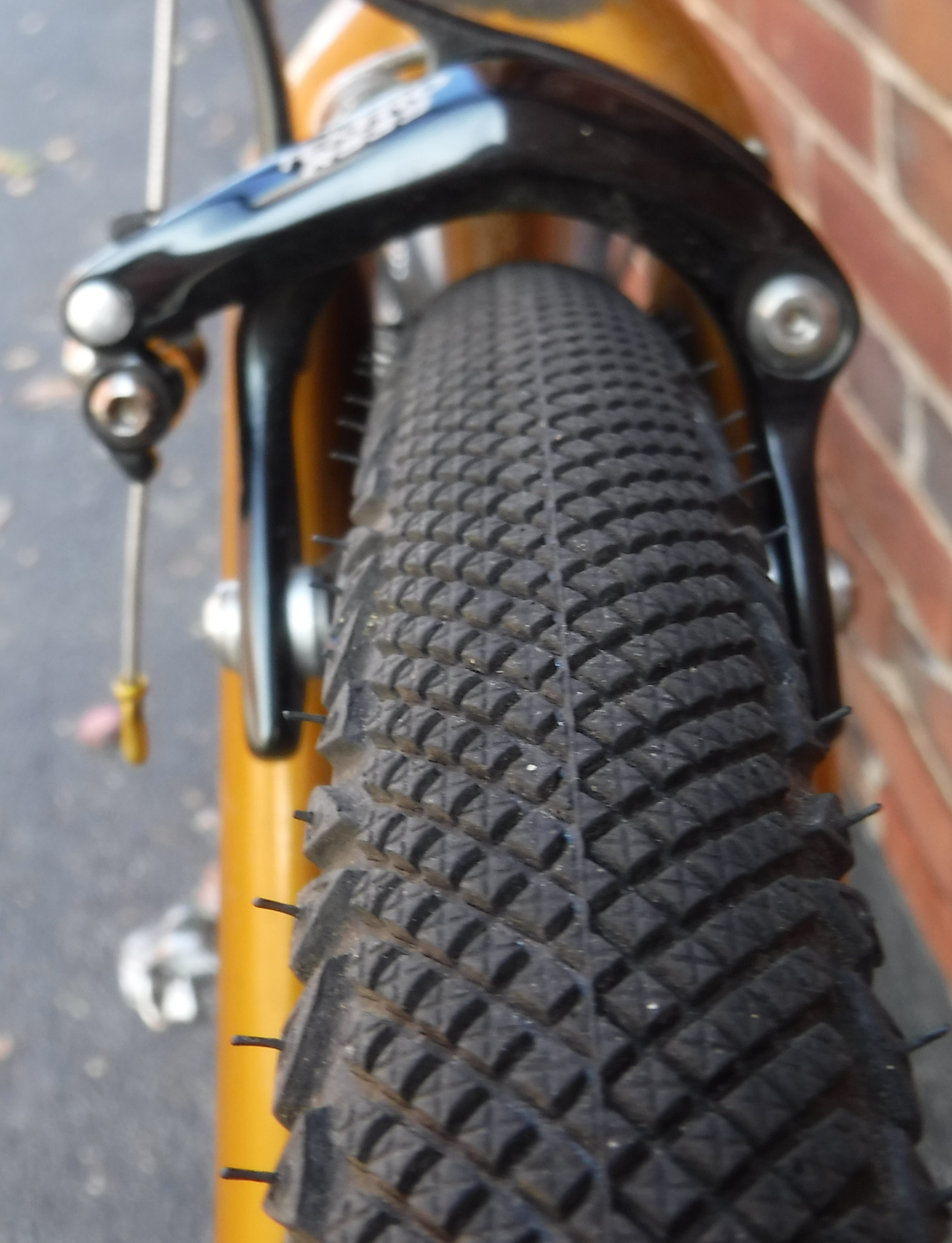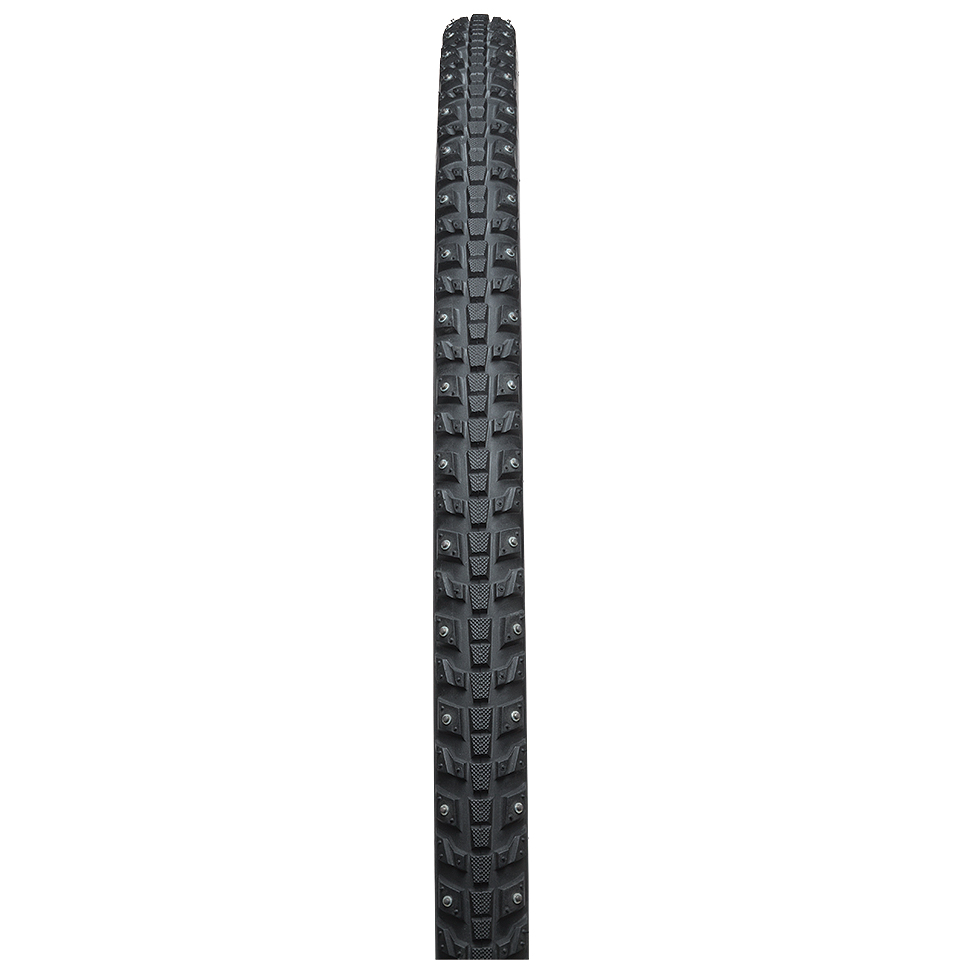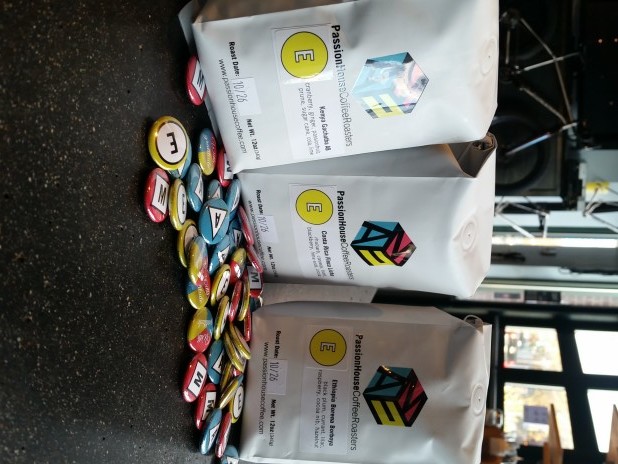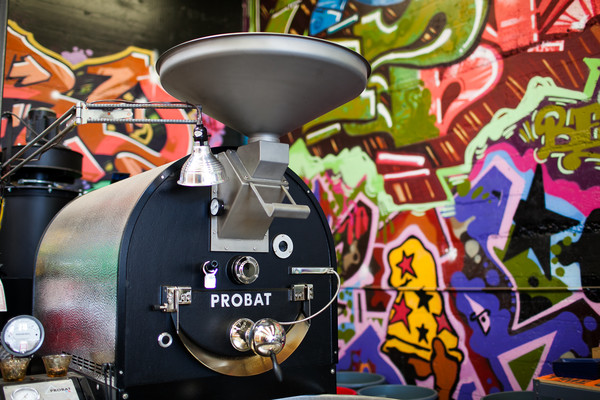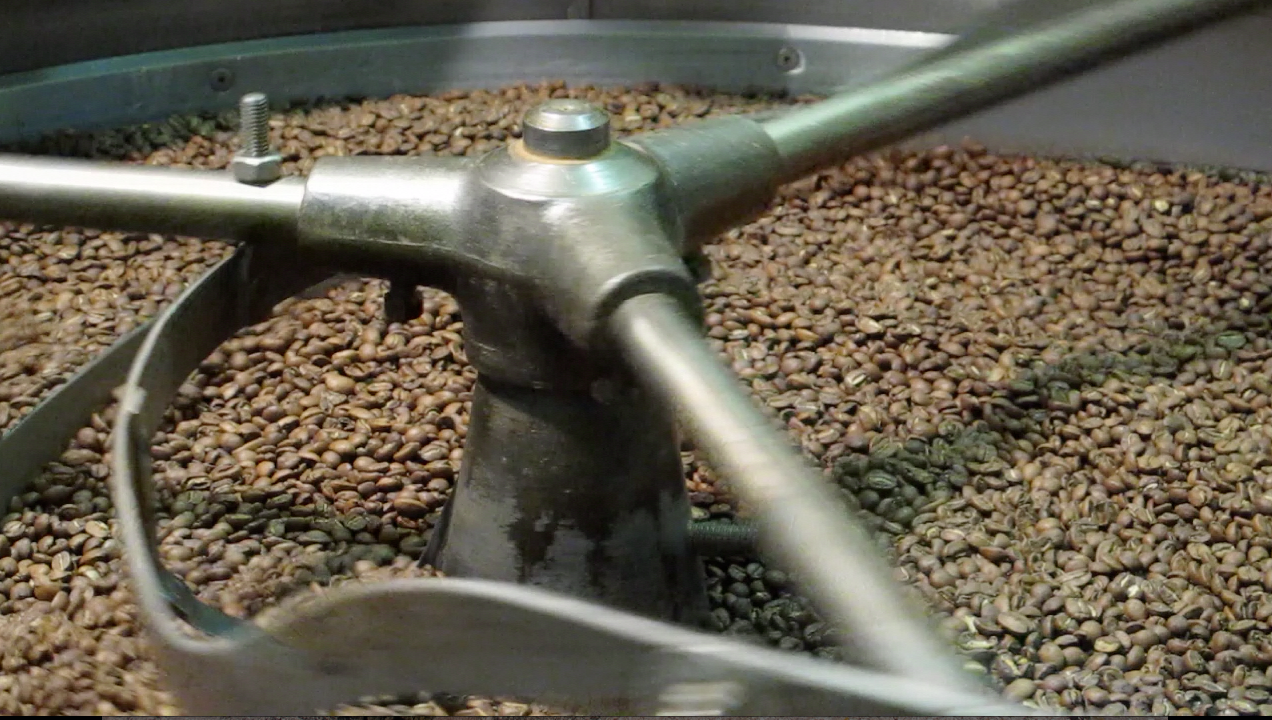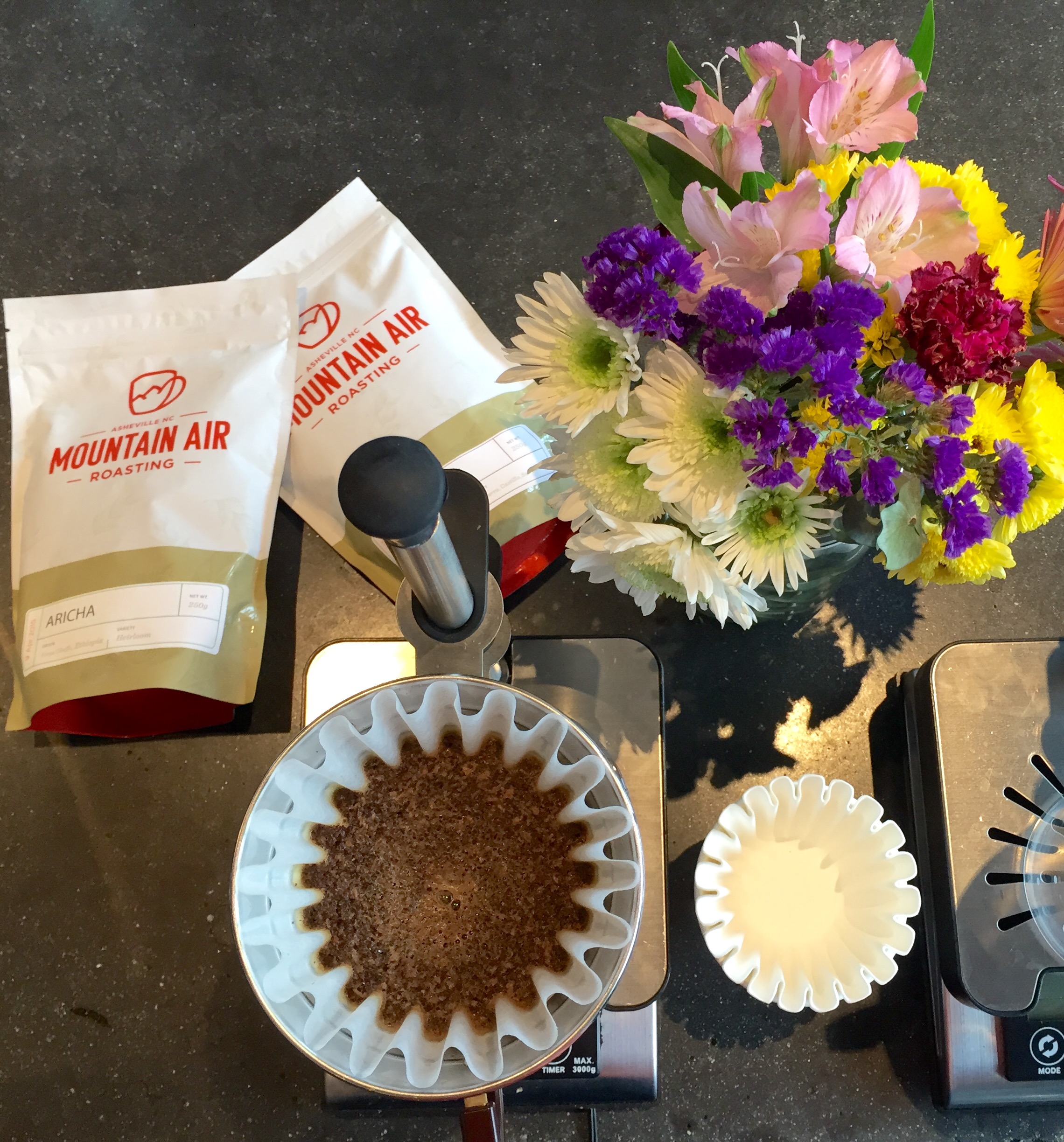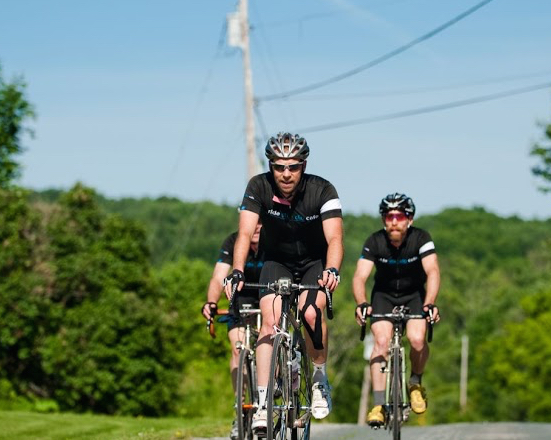Fall Five Stage 1 Results
Fall Five Stage 1 Results - the "Prologue"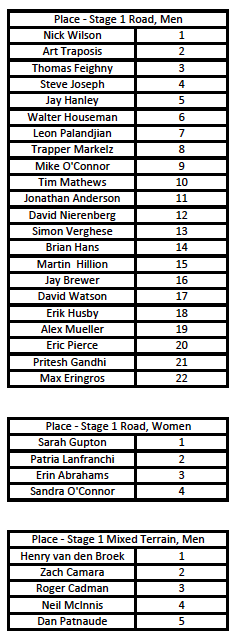
More about the prizes, party, and Overall Results are found on the Fall Five page.
Read our November eNews
Read our latest eNewsletter, there is A LOT going on, starting with a great ride and party this Saturday. Also, the Fall Five starts December 4, check out what that's about, it's a very fun - and unusual - challenge to undertake! We have a new coffee guest roaster in the Cafe, too. Click below on the newsletter to see it all. If it's not coming to your email inbox, sign up to receive it now!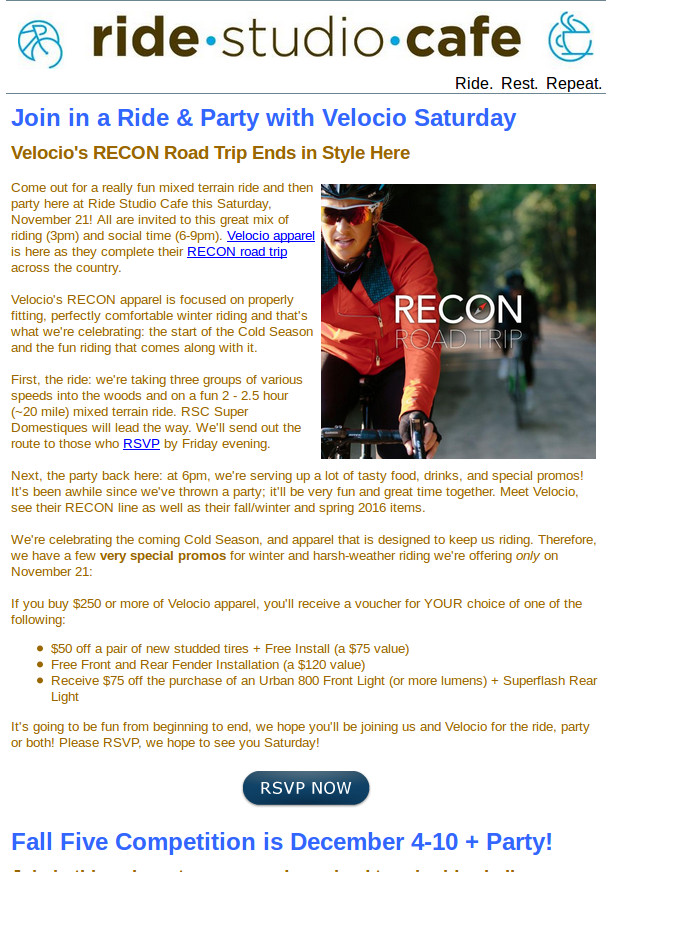
.
Performance Road Bikes Ready for New England
Performance Road Bikes Ready for New England
Remember last winter? Probably. Remember riding on the cold, snowy days? Likely not, but a lot of people were out there having a great time pedaling throughout it. Even though the snow piled up, the roads were often rideable. Cycling through the colder months has become more and more common in New England. Our group rides continue. In fact, the worse the day is, the more people show up, because people like to ride with others when it's cold out.
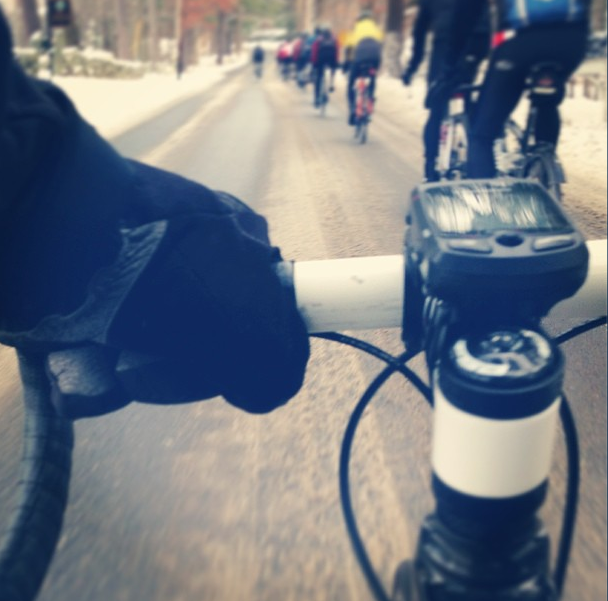
There is no better way to get through the winter than by taking advantage of what it has to offer...outside. We have bikes here that are fast, light, performance bikes for the spring, summer, and fall AND are ready for winter. This is uncommon to find with mainstream stock bikes, but it is common for us to deliver such bikes to very happy people. How is this possible?
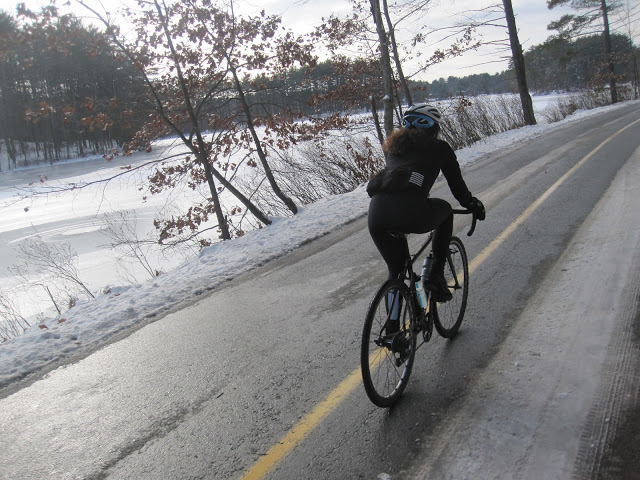
Road bikes with slightly larger clearances that allow for wider tires feel just as fast and responsive as road bikes that barely clear a 25c tire. The difference in frame geometry is minuscule. The mid-reach fork is slightly extended, keeping its stiffness properties and quick handling ability while allowing it to accommodate the mid-reach brake.
Having the ability to mount an LAS file tread tire on a road bike turns said bike into a trail bike. This is a no-compromise setup.
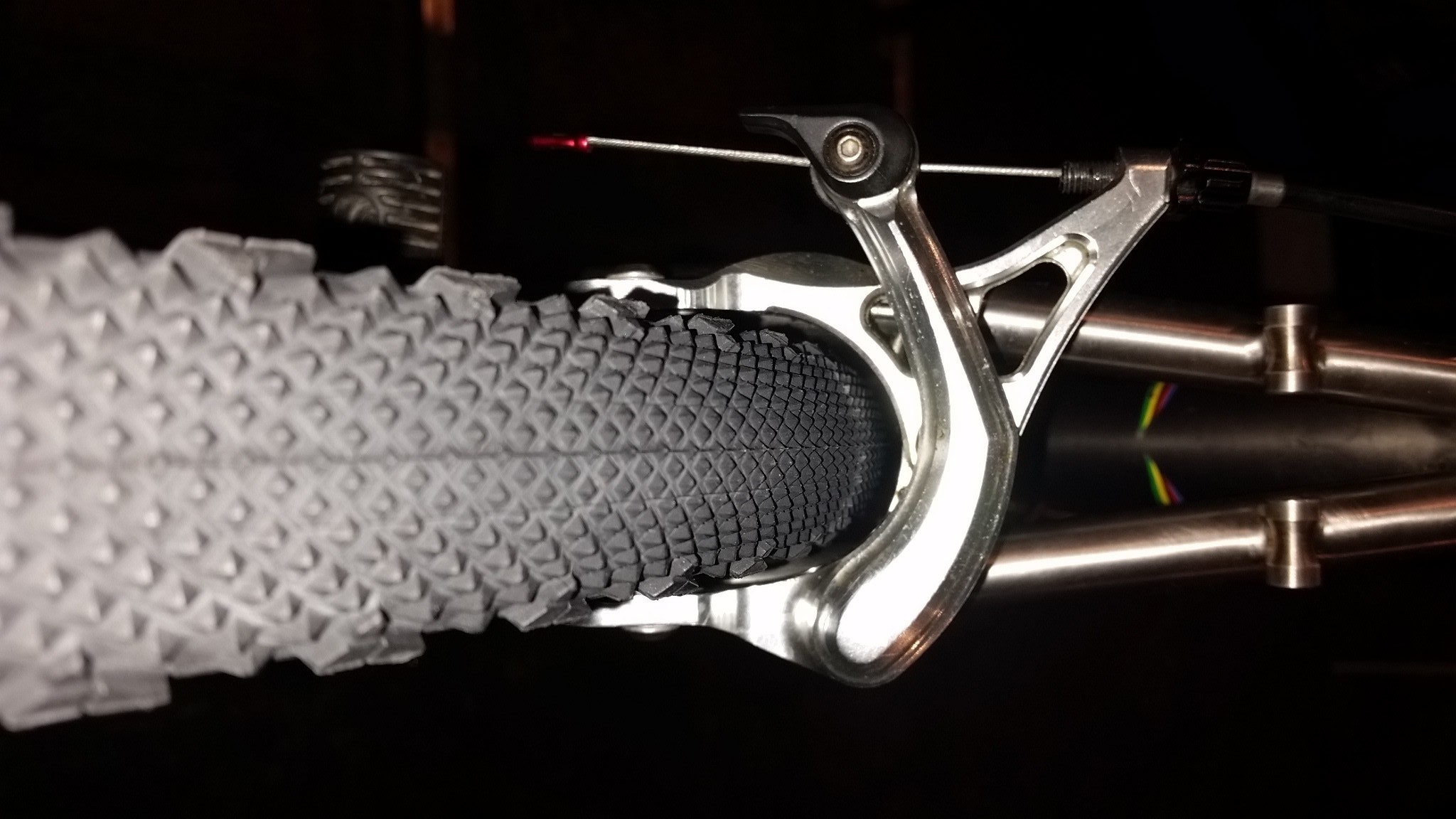
A set of road wheels that typically accommodates a 23c tire is very likely to be able to accommodate the LAS tire.
A tire that's gained much popularity more recently is the Clement MSO 32c tire. This one fits in the brakes and frame with no trouble at all. That's a common choice for road bikes that took on D2R2, a popular dirt-road randonee ride, over the summer.
Or a Continental Speed King - a 35c tire usually only ever seen on a cyclocross bike.
This bike that runs the Continental Cyclocross Speed tire is often seen on group rides with 23c tires. Same wheels (Mavic Ksyrium Elites), different tires, easy swap. It's like two bikes in one. Again, without compromising speed with the skinny tire setup, and not compromising the ability to enjoy dirt trails, rough roads, and have great traction when the roads are wet or slippery.
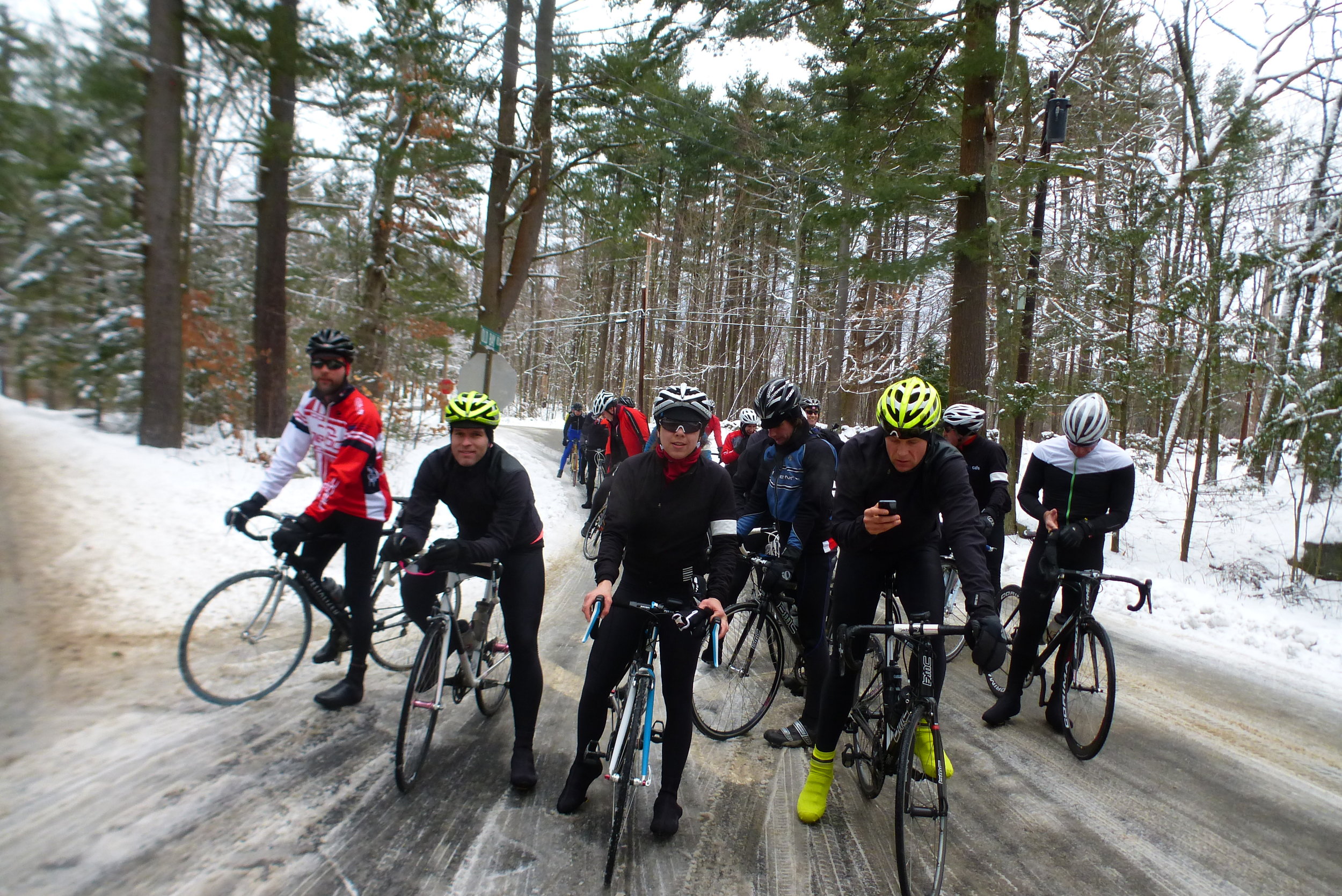
When the roads get icy and riding is still a priority be it for pleasure or for commuting, a studded tire offers ultimate control and confidence.
Both Seven Cycles and Honey Bikes offer fast road bike models that offer this wide range of abilities to ride confidently and quickly throughout the year.
We haven't mentioned disc brakes here and it's no secret that we deliver a lot of disc brake bikes. Disc brakes aren't always the solution, though they're becoming much more commonly seen on stock bikes. Disc brakes, while offering excellent braking power, add weight to the bike and require the fork and other features of the frame to be stiffer and larger than they'd otherwise be on a road bike.
For the person who wants a fast and light performance bike, caliper brakes are usually a very viable, and appropriate, choice. As with all of the bikes we spec, it's important to discuss how the bike will be ridden, where it will be going, and what its intended uses are in the future.
If you want an All-Year, All-Conditions bike, our lead times are awesome at Seven Cycles. In 4-5 weeks, you'll be riding your new unpainted bike. It's 6-7 weeks between now and a new painted bike. If this year is like last year, that is well before the first snowfall. Email us at connect@ridestudiocafe.com to discuss more and if you'd like to demo a great bike similar to those we've highlighted here.
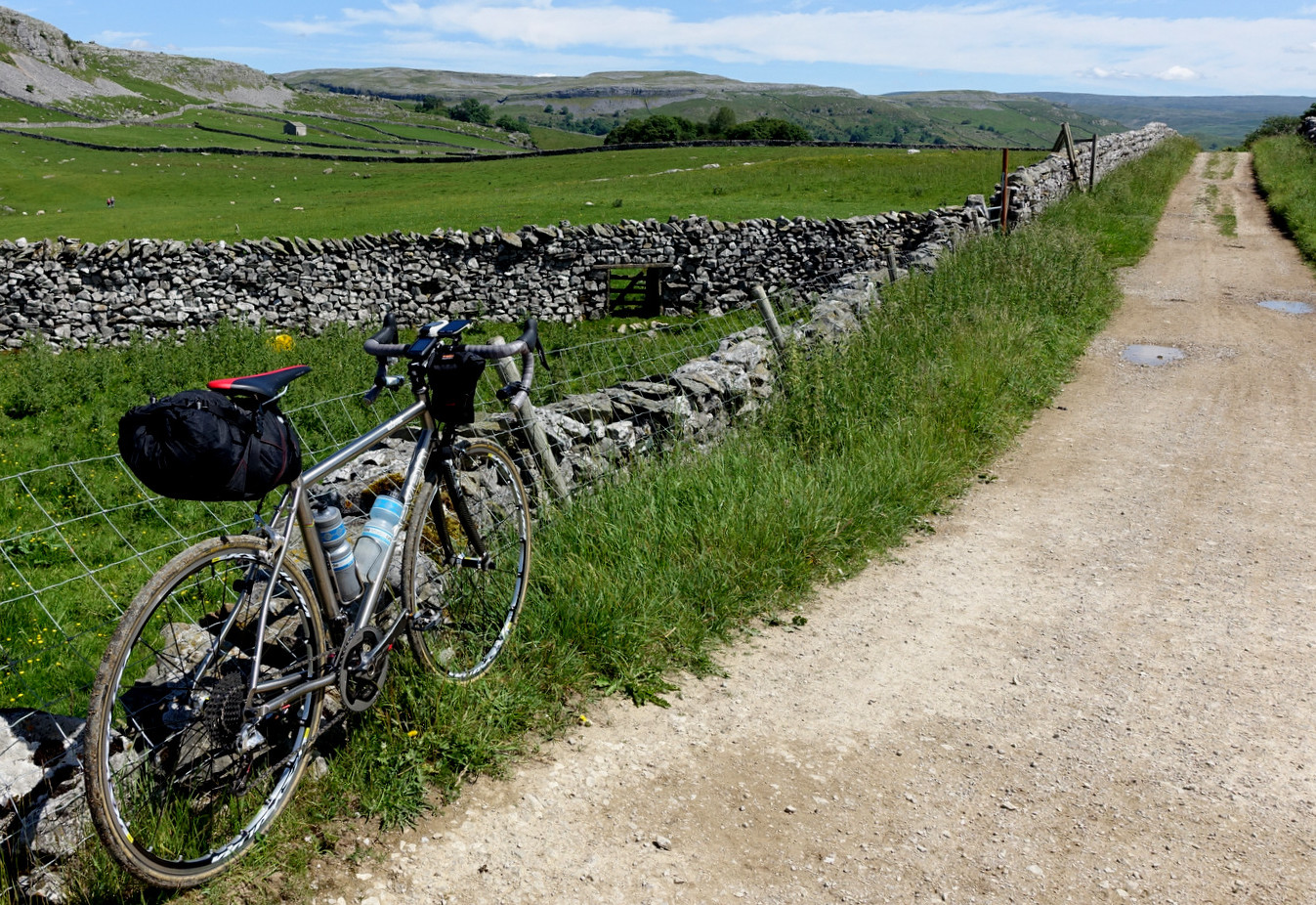
Ending this post on a high note, the spring isn't all that far away and with it comes the warm weather, fast rides, and opportunities to travel with the bike. Travel often involves mixed terrain and, again, the larger-volume tires and/or knobby tires can be just perfect.
Introducing Passion House Coffee Roasters
Introducing Passion House Coffee Roasters
Our new guest roaster is Passion House Coffee Roasters out of Chicago, Illinois.
Passion House was founded by Joshua Millman, a creative individual with years of previous roasting experience. Owned and operated by Millman and creative director Vedya, this small batch roaster takes pride in their artistic approach to coffee. The "AME" logo represents their three genres of roasts. By grouping their coffees into these genres, they hope to spread knowledge of the complexity of coffee and the different ways that it can play with our tastebuds.
The "A" represents Ambient, a genre of roasts containing more mellow flavors.
The "M" represents Mainstream, a genre of more familiar balanced coffees.
The "E" represents Experimental, the genre we will be testing out at first here at Ride Studio Cafe. Passion House's Experimental genre includes the type of coffee we love to serve: single origins and vibrant, complex flavors.
We will be starting out our journey with Passion House by offering their drip coffee. Currently available on our pourover bar is the Ethiopia Borena Borboya, a velvety coffee with notes of raspberry and almond. Up next will be the Costa Rica Finca Licha, a naturally processed and pleasantly bright coffee with notes of passion fruit.
We will be selling whole bean bags of Passion House Coffee as well, and currently we have their Kenya Gachatha, Costa Rica Fincha Licha, and Ethiopia Borena Borboya for you to take home and enjoy. For a limited time, when you buy a bag of Passion House Coffee you also get to take home a complimentary Passion House button.
We are loving the selections so far and look forward to serving Passion House Coffee to our customers!
Fall Five - A Fall Competition for Road and Mixed Terrain Bikes
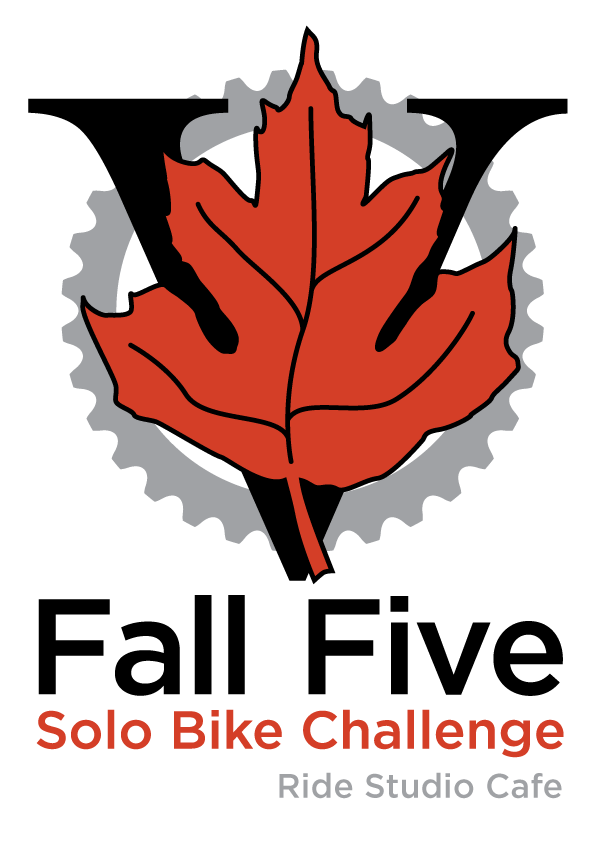 Presenting... The Fall Five
Presenting... The Fall Five
Join the Ride Studio Cafe for the funnest ride series of the fall!
Five Rides, Seven Days, One Big Party, Countless Prizes
Happening from Friday, December 5 through Thursday, December 11. (Yes, the dates changed from mid-November. Later in the fall and later in cross season is helpful for many people's schedules.)
What is The Fall Five?
This is a five-stage solo road AND mixed terrain cycling challenge that is open to all riders with gumption. Each rider chooses whether to complete the road stage or mixed terrain stage; mixing and matching is fine! It’s a fun way to extend the riding season, and each stage is a short, intense effort that’ll keep you warm.
When is The Fall Five?
- Ride Stages: The first stage starts on Friday, December 5. The final stage takes place on Thursday, December 11. Stages 2-4 occur between these days.
- Party Open to All: Friday, December 12 at 6 pm
Why Ride The Fall Five?
Why? Because of the Five P’s!
- Party, Prizes, Personal Challenge, Phun, Promotions Times Five.
How does The Fall Five Work?
We’re racing five stages spread out over seven days. For stages 2, 3, and 4 you have a few days from which to choose; do the race on the day you prefer. This is one of the beauties of this solo race – race at your convenience. And, this makes it easier to participate in all five stages.
All of the Details
Complete Details and registration information are at the ride page:
www.ridestudiocafe.com/fall-five-2015
We hope you join in this very fun event and keep riding through the fall!
Spotlight on George Howell Coffee
Spotlight on George Howell Coffee
Our house roaster, George Howell Coffee, continues to impress with consistency and quality in their roasting. George Howell has built close relationships with coffee farmers around the world and they work closely with the farmers to produce consistently high-quality beans. Delicate inspection and a very careful roasting technique on the part of the George Howell staff leads to the perfect coffee we proudly serve here at Ride Studio Cafe. We visited the roasting facility in Acton, MA to take a closer look at the process.
Past countless rows of corn and vacant fields along Route 2 in Acton, one finds the small town road that leads to the George Howell roastery. The building's nondescript warehouse exterior might fool visitors at first, but inside is a state of the art roasting facility equipped with the best available brewing devices for taste testing and quality control.
20150903_154115 (1)
The coffee beans are frozen at a separate facility directly from the farms in order to preserve the freshness of the coffee and to keep the beans at just the right level of maturity required for roasting. The beans will stay fresh in this state until they are pulled off the shelf to be roasted. The coffee is roasted daily in batches to make certain that it is consumed at its peak of perfection.
At George Howell, roaster Matt takes a precise scientific approach to his work. Using specially designed computer software he charts the roasting process as it is happening in order to track the air temperature inside the drum and adjust the roasting time. The roasting process is so sensitive that mere seconds can completely change the flavor of the end product, so Matt's attention to detail during roasting and the entire staff's quality control afterwards are to thank for the consistency in George Howell coffee.
The roasting facility is home to two different industrial sized coffee roasters. One machine is lovingly referred to as their "Rolls-Royce." This vintage German machine is larger in size and is mainly reserved for their smaller batches. Another new and sleeker machine (referred to as their "Prius") is used for larger batches of their most widely used coffees such as the Alchemy espresso.
After the coffee beans are roasted, they are immediately cooled to ensure that they stop roasting at the intended point. Then, each batch is tested for quality control. A professional cafe setup at the roastery allows the staff to test the coffee on the best equipment available.
Currently here are Ride Studio Cafe we are serving George Howell drip. Right now on the pourover bar we have the Colombian La Piramide, a delightful coffee with rich notes of honey, cherry, and a touch of wintergreen. Up next is the Kenyan Mamuto, a terroir coffee with notes of blackberry, plum, and licorice.
We are thrilled to have had the chance to learn more about the roasting process at George Howell Coffee and look forward to continuing to serve their top quality product with our customers here at the Cafe.
6 Reasons Seven Cycles Randonneur Bikes Go the Distance
6 Reasons Seven Cycles Randonneur Bikes Go the Distance
Paris-Brest-Paris is the most famous of all of the randonneur rides in the world. It is a 1200km ride starting near Paris, France, the furthest point riders go is Brest, then they return to Paris. The clock begins when riders begin in Paris and ends when they return. Therefore, the time they spend sleeping is part of their overall time. Riders also self-support so they bring tools and anything they may need in case of a flat tire or mechanical. They are able to stop for food periodically so they tend to bring front and rear saddle bags, but don't have the load that one who is touring would carry.
There were quite a few Seven Cycles bikes at Paris-Brest-Paris this year. Seven Cycles recently posted about the ride and of Henry van den Broek's adventure there. We worked with Henry to design his bike which is a Seven Evergreen SL.
We've worked on numerous randonneur bikes. Sometimes we don't stop to consider just how many bikes and riders we have on the road. After many hundreds of bikes that we've personally worked on in collaboration with riders and Seven Cycles, we've got quite a few to talk about and share with you.
Photo from Henry v.
What considerations are there when we work with someone to build him or her the ideal randonneur bike?
Note that many of these considerations are taken when we work with anyone on any kind of bike.
Comfort. Long distances are only possible if the rider is in the right position, sitting on the right saddle, being jarred by the road as little as possible. Between working with our professional bike fitter to achieve the perfect bike fit to selecting the proper ride qualities desired for Seven's tube set selection, this extreme comfort is quite achievable.
Matt Roy riding
Durability. It would be a disaster if something were to happen to the bike's frame or parts when a rider is out for a randonneur event. To a lesser extent, imagine if a bottom bracket were to develop a creak. Anything that drives the rider to insanity is just about as bad as having the bike break. Bikes built from the best source of titanium have frames that are extremely dependable. Standard threaded bottom brackets simply don't have the squeaks, creaks, and other issues associated with other bottom brackets. (We've seen and serviced so many squeaky bottom brackets, we can recommend standard threaded BBs without hesitation.)
Seven ExPat
Maintainability. When calling for roadside assistance isn't an option, it's important a rider is able to easily swap in a new spoke for a broken one, or fix a broken chain. For this reason, we usually hand-build randonneurs' wheelsets. We start with a higher spoke count to reduce the chances of a broken spoke. If one were to break, the wheel is often able to stay true enough to ride on safely. Using non-proprietary spokes makes replacing them that much easier.
Light weight. The lighter the bike, the less effort it takes to propel it. Every bit of energy that can be saved is worth a lot. There has to be a careful balance struck between light-weight, comfort, and durability. There are a lot of ways to save weight that are worth considering. This is also quite person-dependent. Frame choice, rim choice, saddle choice are all places where many grams of difference can exist and can make a big difference.
Functionality. Aside from getting a rider from point A to B, the bike can help a rider see and navigate by generating electricity in a front generator hub. When a rider is pedaling through the night, a generator hub and light wired to it is essential for seeing through the night. Lights such as the Busch & Muller Luxos U incorporate a USB port in a handlebar-mounted jack so as to charge small electronic devices such as a Garmin computer or cell phone. A rear light can be wired to the generator hub so the rider doesn't have to concern him or herself with being seen from the rear.
When a rider is riding through the night and sleep-deprived, it is important to have the bike and its systems as simple and easy to operate as possible. The less the rider has to think about the better.
Aesthetics. Henry shows in photo after photo that aesthetics are important. What's right for one person is just that: right for that person. If someone is going to be riding for hours, days, weeks, and years on this machine, it'd better look appealing to get on! There's nothing like parking a bike by the side of the road and capturing scenic views with the bike in the foreground.
Every detail from the feel of the bar tape to the width of the tire is important. We have many years of experience with randonneur riders and randonneur bikes. Simply stated: we help riders get on bikes that go the distance 24 hours a day, seven days a week...without limitations.
A Brief Look at What's Happening: Group Rides
A "Brief" Look at What's Happening
The number one question I get on a daily basis is: "So what's happening at the Studio?" My answer is usually a long pause while I try to think of all of the upcoming rides, events, new products hitting the shelves and then I blurt out: "A whole bunch of everything." That's not a very concise answer so here's an attempt to answer this seemingly simple question with the details you're looking for.
Group Rides
We've had a full year of really awesome rides - and we're continuing to ride as the weather changes. Our weekly rides have been very well attended. In response, we have added more good rides to the line-up. Here's what's new:
Saturday 8:15am Horizon Chasers - This long, moderate ride has been running all summer, but it just got a name. Every week it has a different route, usually between 60 and 80 miles. This coming Saturday's edition of the ride will take in peak fall foliage. So, we'll call it the Leaf Chasers for this week. Everyone who can maintain a 16-17mph average pace for the distance is welcome to attend. The distances will go down and the ride will migrate forms with seasons. We'll keep this running as long as we can.

Saturday 8:30am Redline Ride - This is a 60-mile fast, drop ride. Groups are 10 people or smaller to keep the ride safe. When we say fast, we mean it. All we ask is that participants sign up in advance, so we know who is riding at which speeds.
Saturday 9am Espresso Ride - This ride is the Saturday version of our Sunday Coffee ride. There are two groups rolling at 16.5 mph average and 17.5 mph average. The route is different from Sunday's Coffee ride.
Rides are Led by RSC Super Domestiques
We put together a very special group rider training session with Mark McCormack in early September for RSC Super Domestiques. Our Super Domestiques are largely comprised of our most active group riders who ride well and have vested interest in group rides being safe, fun, consistent, and welcoming to new riders. We've put special emphasis on having smaller groups roll out together and we remind riders of the rules of the road before each ride. This has really helped tighten up rides. We even had one group receive a compliment from a Concord police officer who was driving behind the group and was pleased to see the group riding together two-abreast.
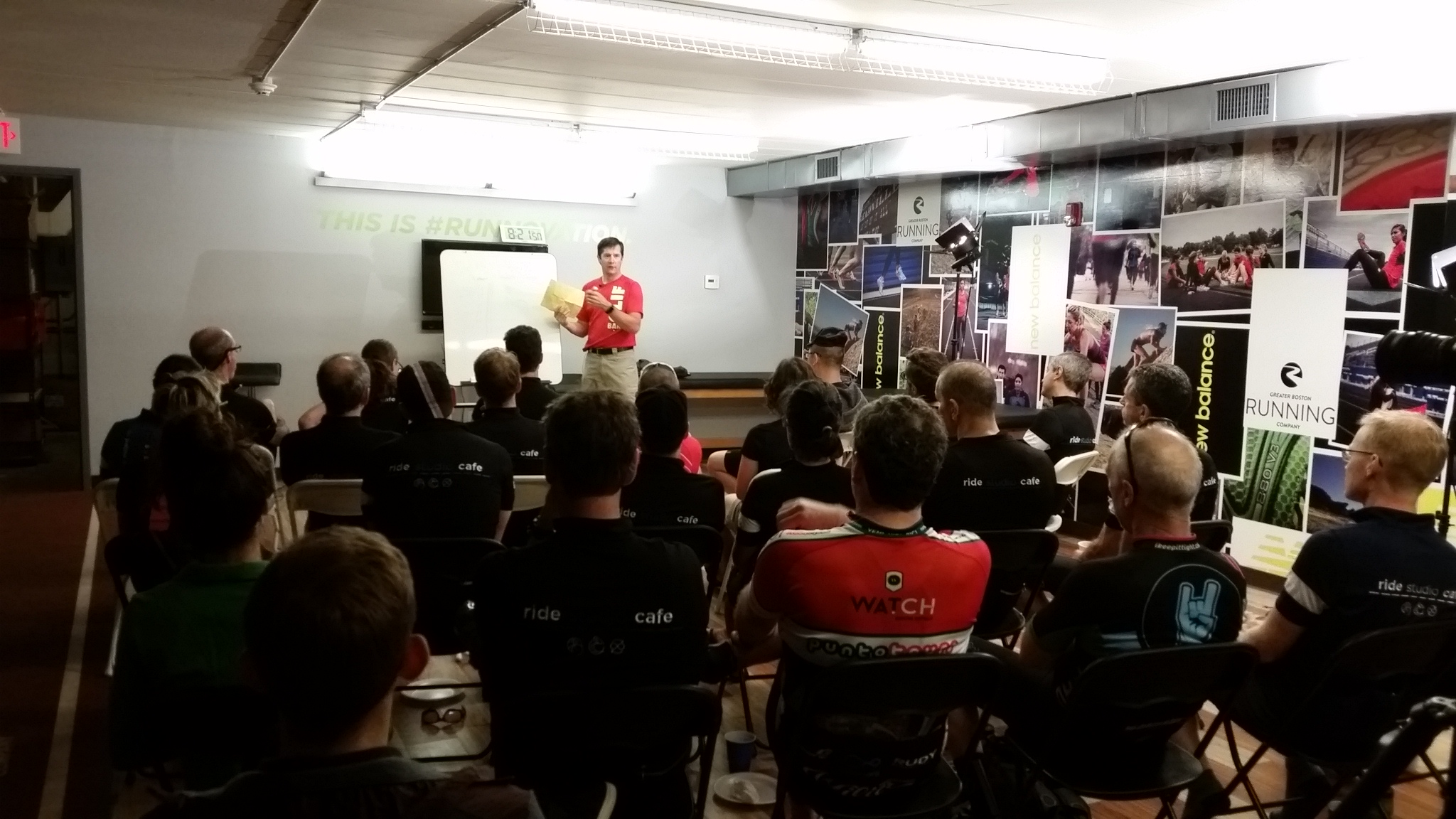
Please let us know if you'd like to join the cadre of RSC Super Domestiques!
Special Rides
Remember back to January and February of this year? Yes, it was white out and a bit chilly. We were out there riding. And we put together the Conjure Series of rides to get some good weather and dry pavement. It worked--that was the beginning of a lot of cool rides.
Our Randomneur Series treated riders to very, very long rides in every direction. This was a series of four long rides, all named after famous randonneuring rides. The longest, and most popular of these ran 143 miles to Provincetown.
We've had a lot of fun hosting Overland Base Camp's series of rides which included the Maneha 250, Dusk to Dawn (& the many Dusk to Dawn pre- and post- training rides), Honey 100, and, most recently, the Formidable Pave Ride.
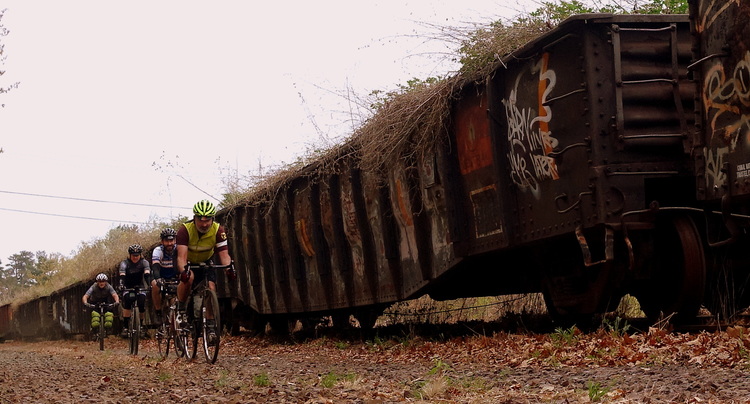
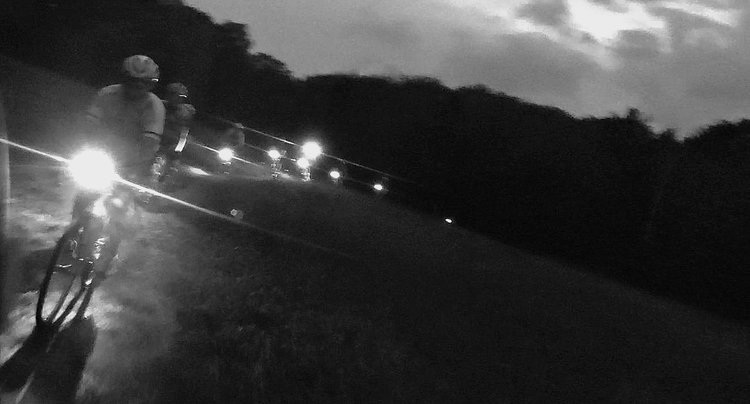
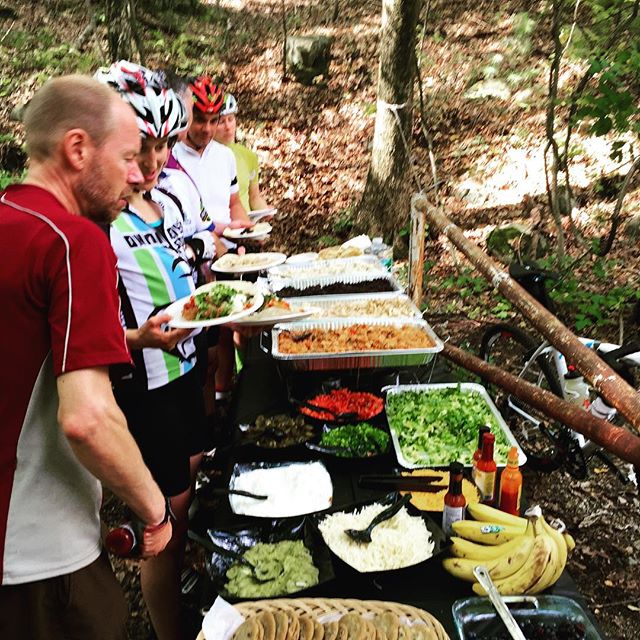
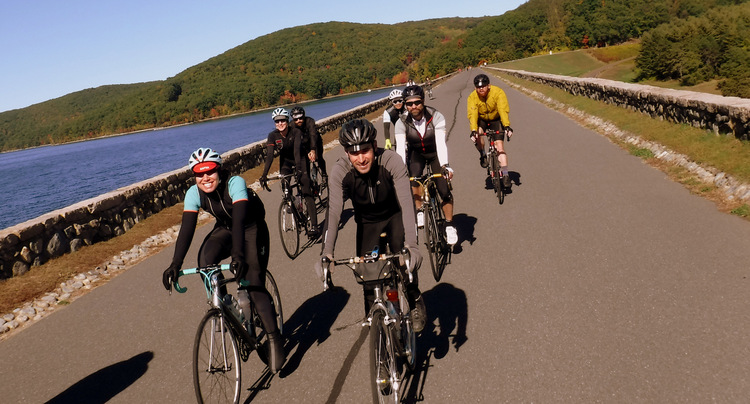
These Overland Base Camp rides will be back in 2016! Start planning and preparing now. Anyone who properly prepares for these rides and has the right equipment can do any of them. The We'll let you know the dates for each when we receive them on our master Ride Calendar.
Special Rides and Events Upcoming
Fall Five: Friday, November 13 - Thursday, November 19
The Fall Five is a competitive, solo event where riders complete a series of rides following a Garmin or other routing device, then results are compared with everyone who is competing the same event. We ran the last edition of the Fall Five during the hurricane of 2012. We are looking forward to doing it again - just without the hurricane. The routes will keep everyone on their toes and the terrain is unlikely to be smooth or flat. Winners, not-winners, and everyone who was part of the cheering section are all invited to a post-event party at RSC on November 21.
November 21: Velocio RECON Ride and Party
We are excited to be carrying Velocio apparel on our shelves. Velocio is visiting us on November 21 so we'll be hosting a fun, 2-hour mixed-terrain ride starting at 3pm, then concluding with a party back at the Studio. The Velocio RECON road trip concludes here. Their RECON collection is ideal for a New England winter, and this will be a great opportunity to meet them and their apparel. Check out the Details and be sure to RSVP.
December 12 - Women's Braver than the Elements
The women's Braver than the Elements ride is of the mixed terrain variety this year. The training rides leading up to this keystone end-of-year event are also mixed terrain. Road bikes with 25-28c tires are appropriate for the next training ride of 25 miles in length which is on Oct 31. The next two training rides on November 21 and 28 all require wider, knobby tires and cross or mixed terrain bikes.
If you had your calendar marked for December 5, the date was just changed to December 12 for the Braver than the Elements ride event.
January 23, 2016 - All Conditions Ride
Overland Base Camp is running an All Conditions ride during a time that promises to offer just that. Details are up - start planning for it and the Winter Tide Ride Overland is planning!
Get Ready!
I promised this to be "brief." Now you understand why there isn't a short answer to the "What's Happening?" question! It's important for you to know that we are rolling right through the winter -- through what we're calling the Hot Drink Season. There is no "off" season in New England. Riding conditions just change somewhat. Be ready for the snow and the tougher conditions: get gear such as a good pair of gloves, cycling boots, lights, and a set of snow tires. We will be writing a lot more on how to be prepared as the temperatures dip. But start thinking now about staying outside. It'll be far easier to keep riding than to stop and try to start again on a really cold day.
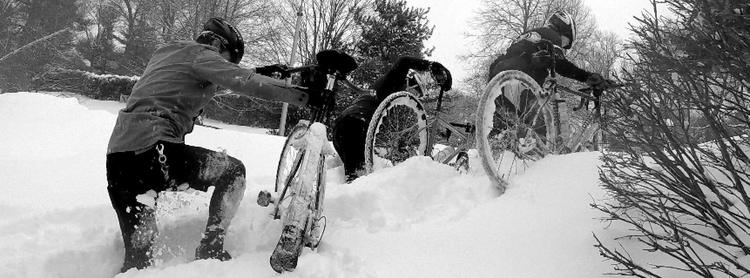
Welcome Coava Coffee, Guest Roaster from Portland, Oregon
Welcome Coava Coffee Roasters
We are very excited to announce the arrival of a new Guest coffee roaster in our Cafe. We are now serving up delicious roasts from Coava Coffee of Portland, Oregon.
With any adventure there are always great stories that come out of it. Coava's story begins in the garage of Matt Higgins. Matt started bar tending at local shops while finishing his undergrad at University of Oregon. Soon after graduating, Matt found himself wanting more than what his degree in German was offering him.
Already having a variety of talents under his belt, such as his time at the renowned Albina Press coffee bar, he decided to start trying things for himself. From the very beginning, Coava was focused on pursuing such ideals as sustainable farm practices and a quality product from farm to cup. Matt and his team dove head first, exploring the arts of agricultural science, sustainable business practices, and direct farm relationships. Matt once said in an interview with Joshua at FoodGPS.com, that "The most exciting part is bringing in a coffee that someone has never tasted before, a separation that’s maybe never been separated before, a farmer who’s never had his or her name mentioned ever, because their coffee’s been routinely blended away." This is how we think at RSC when it comes to roasters and their product: emphasizing the work that goes into making a great cup of coffee, and enabling us to showcase the talents of the region, the farmer, the roaster, and the barista.
For the first few weeks we will be serving an array of filter options made available from Coava.
The varieties will range from the consistently good Costa Rica Los Nacientes, to the uniquely funky and naturally processed El Salvador La Esperanza. We also will have a similar natural heirloom Ethiopian, Kilenso. Something we are really excited about is serving a well-crafted and consistently-produced natural coffee. Coava does these well! For more on natural processed coffees check out our previous coffee blog posts on the different types of processes used around the world. We look forward to what these next weeks in coffee have to offer.
This Week in Coffee: Farming- Processing Part
This Week in Coffee: Farming- Processing Part 2
In these days of summer heat, we are staying cool in the studio with many wonderful iced drink offerings. Come in from the humidity and refresh with a nice cold Spindrift soda, Iced Yunnan Tea from Mem Tea Imports, or Iced herbal tea option, Ginger Lime Rooibos from Rishi Tea.
Of course, we are also offering some wonderful iced coffee options for a cool down complete with a boost of caffeine. Always popular is our cold brewed iced coffee. Enjoy a full 12 oz cup or a quick shot of energy from our small 4oz option. Also available when reserved a day in advance is a 64oz cold brew growler that you can keep in your fridge at home or work to enjoy throughout the week.
This week our espresso is brought to you by our current guest roaster, Mountain Air Roasting of Asheville, North Carolina. Currently is the hopper is Heirloom espresso. This Yirgacheffe, Ethiopian is floral, spicy, and intense. Next up this week we will be Obelisk espresso from Brazil. This option is smooth and delicious with flavors of honey, chocolate, and cherry. Looking for the full flavor of espresso in a cold drink? Any of our espresso drinks can be made iced.
Of course, even in the summer, hot coffee is a wonderful option is get your day going. Currently on our pourover menu are two wonderful offerings from George Howell Coffee. San Jose de Pedregal from Colombia is rich with flavors of black grape, dark cherry, and orange. Reko Kochere from Ethiopia is bright and sweet with flavors of watermelon, apricot, and candy lemon.
Focus on Farming: Natural Processing
Since February we have covered many topics to introduce some of the complexities of coffee farming and production. We started with a basic overview, followed by a focus on soil effects, climate conditions, altitude, varietals, and harvest. Recently, turning to the processing of coffee, our last post focused on the traditional washed process for removing the coffee cherry fruit from the coffee bean. Today, we write about a less common processing option: natural processing.
Natural processing (or dry processing) is the oldest way to process coffee and plays a large role in effecting the taste of coffee once it is roasted and brewed. Typically naturally roasted coffees present with a fruity flavor that washed processed coffees cannot achieve. This is because in the natural process, the fruit of the coffee cherry is allowed to dry on the coffee bean before being removed from the seed. This allows the bean to assume that fruity or berry flavor. While a vast majority of the coffees we serve here at the studio are traditional washed coffees, we have had opportunities to serve natural processed coffees in the past: most recently, Misty Valley Ethiopian from
.
Read the Latest eNews
Read the Latest RSC eNews
If you aren't receiving our eNewsletter in your inbox, be sure to Sign Up to receive the next edition now!
Click below on the newsletter to read our latest eNews. Don't miss out on the early registration deadline for the Dusk to Dawn ride, either!
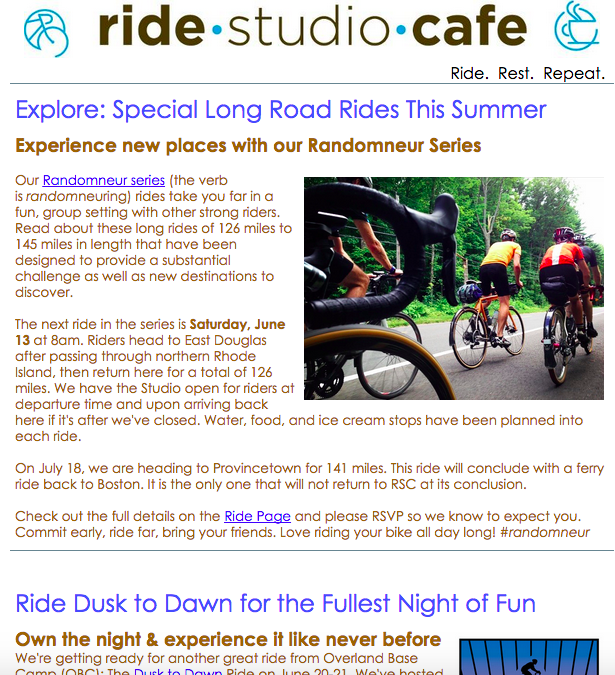
Ride Dusk to Dawn for the Fullest Night of Fun
Ride Dusk to Dawn for the Fullest Night of Fun
Mixed Terrain Riding Just Became Even More Full of Adventure
We're getting ready for another great ride from Overland Base Camp (OBC): The Dusk to Dawn Ride. We've hosted two rides for OBC so far this year -- the Diverged Ride and
the Maneha 250.
Both have been big successes. If you missed either of these rides don't miss the Dusk to Dawn Ride.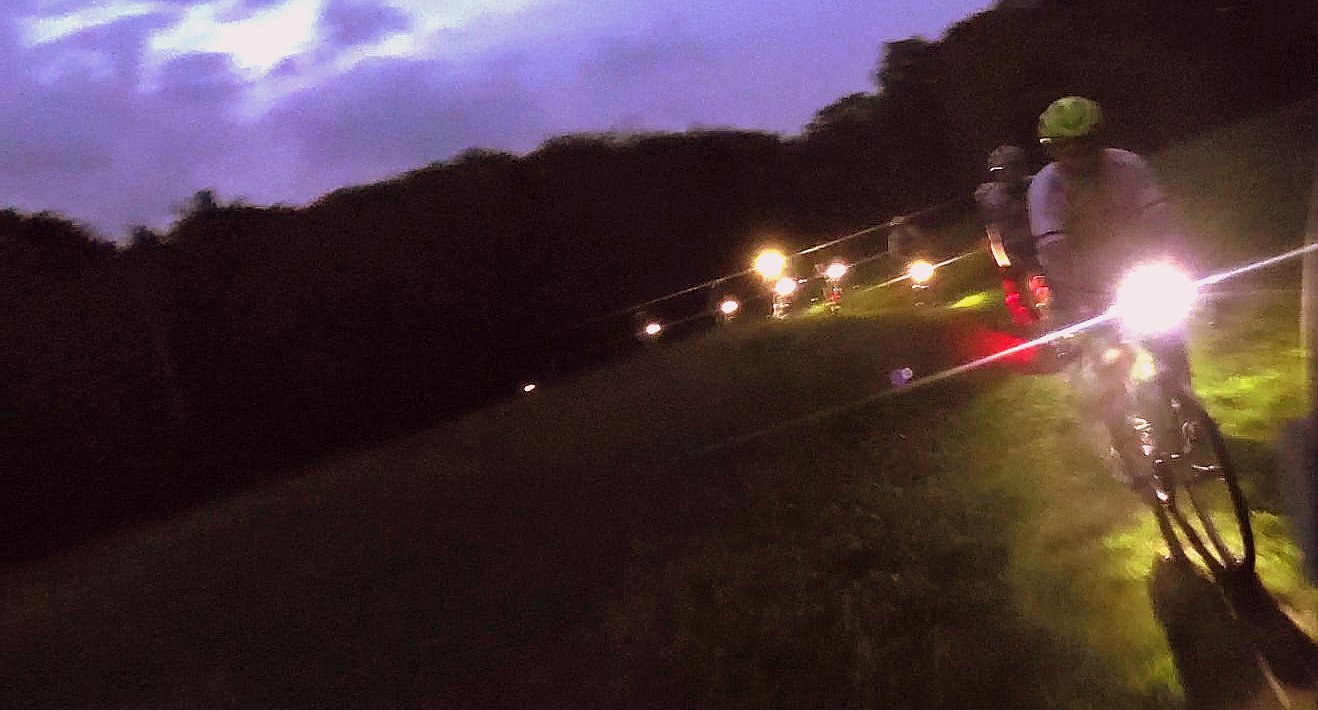
- What: As the name stipulates: Riding from dusk to dawn. In addition to night riding, this is a mixed terrain about 50% of the ride will be pavement and 50% on dirt: dirt roads, singletrack, fire roads, goat paths, and other terra incognita. The Dusk to Dawn offers two distances and levels of challenge.
- When: June 20 & 21, 2015. From sunset on Saturday through sunrise on Sunday. You can be home on Sunday before 9am or earlier!
- Where: Heading out from here Ride Studio Cafe in Lexington, MA. Almost two-thirds of the way through the ride we'll meet at a big fire for a late dinner - and an electronics recharging station.
- What you'll need: Bikes, lights, dirt tires, GPS units, SPOTs, and lots of food.
- Why: It has to be done. Night riding in the summer is about as good as it gets.
- How: Register at Bikereg.com
We hope you'll join us for this unique event!
Questions? Email Overland Base Camp.
Multiple Ride and Participation Options:
- Continuous: Ride the full 90-mile route without sleep.
- Campout: Ride the first 55-miles and then campout -- sleepover -- at the fireplace. We have tent options and wet weather options. OBC hauls your camping gear, a change of clothes, and whatever else you want at the big fire.
- Teams consisting of 3 - 6 riders: Each team member starts and finishes the Dutodari together; you get to roll through the night together.
Ride Statistics
- Distance: Two options: About 90-miles and about 55-miles
- Elevation Gain: About 6,500 feet for the 90-miler
- Terrain: Mixed. 50% dirt; 50% pavement
- Geography: Suburban and some urban
- Territory: From deep woods to well-traveled roads
- Sky: Dark
For those that sign up very soon there are still a few Dawn to Dusk custom-made caps left for early registrants. When they're gone, they're gone.
We hope to see you at the Dawn to Dusk Ride! #d2dride #overlandbasecamp
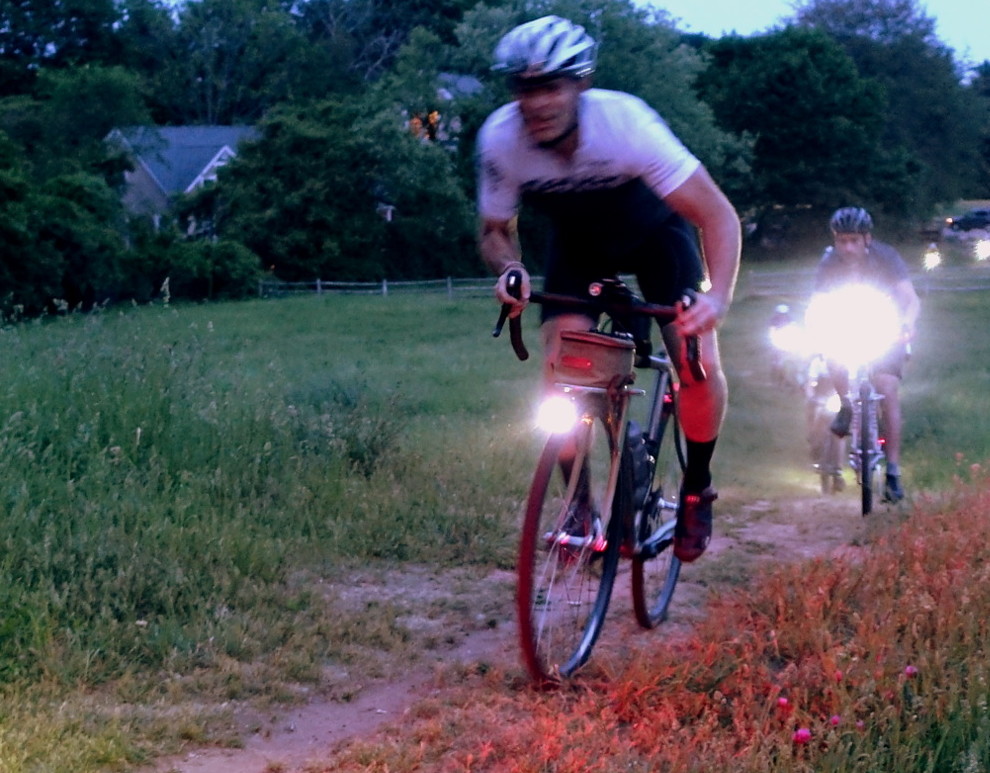
This Week in Coffee: Farming-Processing Part 1
This Week in Coffee: Farming-Processing Part 1
For the past few weeks we have been serving up some delicious pourover coffees from our current guest roaster, Mountain Air Roasting of Asheville, North Carolina. Today we are switching gears and serving up Mountain Air espresso with pourover options from George Howell Coffee.
Mountain Air's American Espresso is a Colombian coffee from the Huila region that tastes fruited, bright, and lively, and pairs beautifully with milk to become your favorite espresso drink. From George Howell we have an old favorite, Borboya from Ethiopia and a new option, Quispe Senk'a from Peru. Borboya is light and floral with notes of sweet lemon, lavender, and green tea. Quispe Senk'a is fruity and tropical with notes of pineapple, sangria, and passion fruit.
Also available and perfect for the summer like heat we have been experiencing, is our cold brew. Want easy access to cold brew at home or at the office? Reserve a cold brew growler today and pick it up tomorrow!
Focus on Farming: Washed Processing
After a bit of a hiatus, we are back with our Focus on Farming Coffee series! This winter's posts included details on some of the various factors that effect the growth and taste of different coffee beans including a basic overview, soil effects, climate conditions, altitude, varietals, and harvest. Now, moving past the growing process, we are turning to the next step in coffee production: processessing. There are a few different ways to "process" coffee, or remove the fruit of the coffee cherry from the coffee seed or bean, preparing the freshly harvested coffee for roasting. Today's post is dedicated to the most common manner of processing: traditional washed processing.
Washed processing completely removes the cherry and pulp from the coffee seed through friction, fermentation, and a water wash. Fresh from the harvest, the coffee is first weighed and then fed through a depulping machine (pictured above) which uses blades and a water wash to remove the fruit, leaving a thin layer of mucilage coating of natural sugars and alcohols on the bean. This mucilage has a great impact on the flavor of the coffee and after depulping, must be fully removed from the coffee bean. This can be done through fermentation or mechanically.
Depending on several factors, including desired flavor, amount of mucilage, and climate conditions, fermentation can take as few as six hours or as long as four days. Turbulent water and naturally present bacteria break down the mucilage and can remove 100% of the sugars and alcohols. Mechanical demucilagers can strip most of the mucilage, but not all. This new technology can be carefully calibrated to remove a controlled amount of mucilage by applying friction with bristles. This method also uses a considerably smaller amount of water and produces less waste.
After washing and fermentation, coffee is spread out to dry. At this point in processing, the coffee is still surrounded by a protective parchment skin. When drying, the coffee bean shrinks, allowing for easy removal of the parchment in a final step of preperation: hulling. Once the parchment is removed from the dry bean, the green (or unroasted) coffee is ready to be packaged and shipped to roasters around the world.
For more information on washed processing, check out this page on the Stumptown Coffee website. This photo page from George Howell's 2007 trip to Kenya also includes some great photos and descriptive captions of traditional washed processing.
Diverged Ride 2015
Special Ride: Diverged
Saturday, April 25, 2015
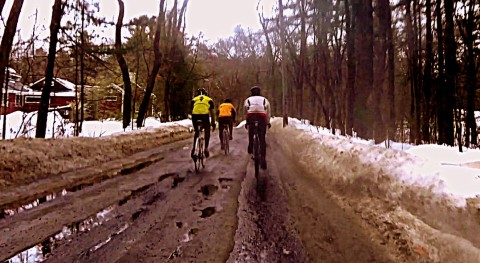 Update: Routes are Posted
Update: Routes are Posted
Diverged 2015
Details:
The Ride Studio Cafe is hosting and Honey Bikes is sponsoring this very special early spring ride!
This is just a high-level view of what's happening on April 25. For all of the details and to RSVP, go to the Ride Page on the Overland Base Camp website.
Ride: Diverged Ride. All surface types will be represented: pavement, gravel, dirt, and rocks. There are two ride distances: either 17 miles or 38 miles and fun, medium, and fast paces, too. Each group will have a ride leader so you're not on your own.
When: Saturday, April 25 - Various starting times for the different groups
Where: Departing from Ride Studio Cafe.
Why: Honey Ride! All bikes welcome – with some required modifications – see below.
How: On randonee bikes – or modified cyclocross bikes – see details below.
The ride’s name - Diverged – comes from Robert Frost’s poem The Road Not Taken. Because on this ride, we’re taking all the roads and trails. We’re fortunate to have bikes, rather than being on foot, so divergence is a good word. Because this ride is a bit unusual we have a few special bike requirements.
Bike Requirements
- 28c tires, minimum size. If you don’t have 28c or wider, you’ll be riding alone after you get a flat. If it looks like mud, we'll suggest knobby tires like the Schwalbe Racing Ralphs (33mm) or Clement MXP (also 33mm). If it's dry, then any 28c slick tire such as a Ruffy Tuffy 28c, Continental Grand Prix 4-Season, or wider like the Jack Brown 33c will work and knobby tires will just make it easier from there. Watch Twitter for up-to-the moment recommendations as we near the weekend.
- Spare tube or two – with all the tools required to fix a flat – or two.
- Fenders – only if it looks like it'll be so messy that your riding companions will thank you. Otherwise, leave them at home.
- Basic tool kit: Self sufficiency is the phrase of the day. The group will wait for you if you have a mechanical – in fact we’ll even help – but you don’t want people waiting trail-side too long on a chilly morning.
If you don’t have one or more of these items, you’ll want to get them at the Ride Studio Cafe before that Saturday morning.
Breakfast
-
Honey-Centric Pre-Ride Breakfast – on the house at the Studio starting at 8am. Come hungry.
The Ride
This ride offers an extremely diverse set of terrain. On the one hand, Honey has ridden the entire route on a 23c road bike and had a blast. On the other hand, a few have ridden the route on a fully decked out cyclocross bike – knobbies and all – and felt that a mountain bike might have been nice. So, this ride has it all, a bit of technical handling all the way to multiple kilometer stretches of paved road. Bring your 28c+ tired bike and you will have a blast.
Rain or shine, we’ll be smiling through the entire ride.
If you’d like to join the ride, please RSVP in advance – we’ll save a biscuit for you!
A slideshow of photos we took (or were emailed from participants) from the Diverged 2014 weekend is up! Thanks to all who came and rode Diverged with us and Honey Bikes!
This Week in Coffee: Introducing Mountain Air Roasting
This Week in Coffee: Introducing Mountain Air Roasting!
This week we are thrilled to announce the arrival of our newest guest roaster, Mountain Air Roasting of Asheville, North Carolina! Mountain Air applies a gentle roast process to fresh, high quality coffees with the goal of maximizing and highlighting the natural fruit flavors of the coffee bean. With a focus on freshness and quality, Mountain Air maintains their mission "to serve you the best cup of coffee you have ever had, every morning." We are very excited to have them here at the Studio and can't wait to try out everything that they have to offer!
This week's poverover coffees from Mountain Air include and Ethiopian Aricha and Colombian Luis Tovar. Aricha comes from the Yirgacheffe region of Ethiopia and is rich with flavors of tamarind, lavender, and white grape. Luis Tovar is from the Huila region of Colombia and presents with flavors of plum, cranberry, and lime.
Also available in the cafe is espresso from George Howell Roasters. Currently in the hopper is Borboya from Ethiopia. This amazing espresso presents with flavors of candied lemon, lavender, and semi-sweet chocolate. Also available is a Colombian decaf espresso with flavors of cherry, chocolate, raisin, and maple.
Come on by, try one of these new exciting options, and chat with us about the ins and outs of coffee!
Latest eNews in Your Email
Latest eNews in Your Email
Our latest eNewsletter that is delivered to your email inbox is out. If you didn't receive it, search for "Ride Studio Cafe" and see if it arrived in another place in your email. If you haven't subscribed, be sure to do so, there is a lot of news we have to share with you! We don't share your email address with anyone and we publish a newsletter every 2-4 weeks. Subscribe here. Click below to read the one we just published yesterday evening. We hope you can join us tomorrow evening and for the special rides coming up soon!
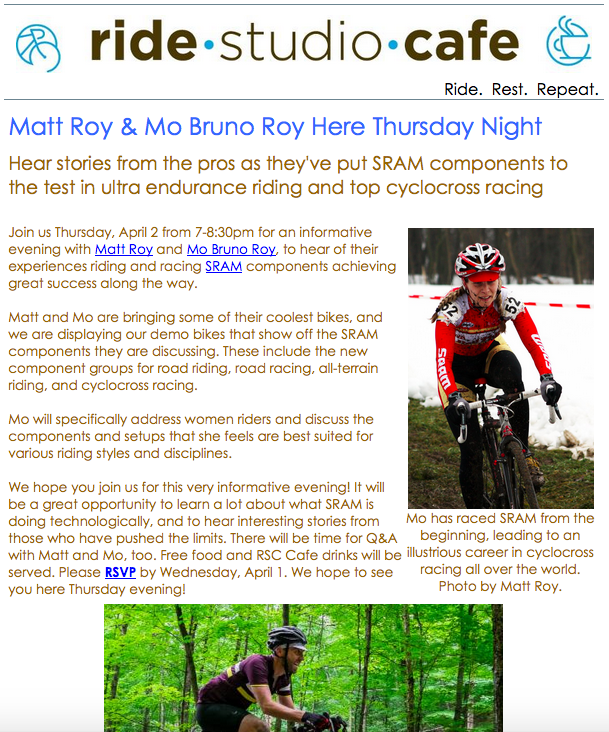
Riding Essentials for Your Bike
Riding Essentials for Your Bike
Having a bike properly equipped with the basics should a flat or unforeseen situation occur means many fewer things to think about each time you grab your bike to go on any kind of ride. We'd like to share our list of the best items to include on your bike and where they go for maximum convenience.
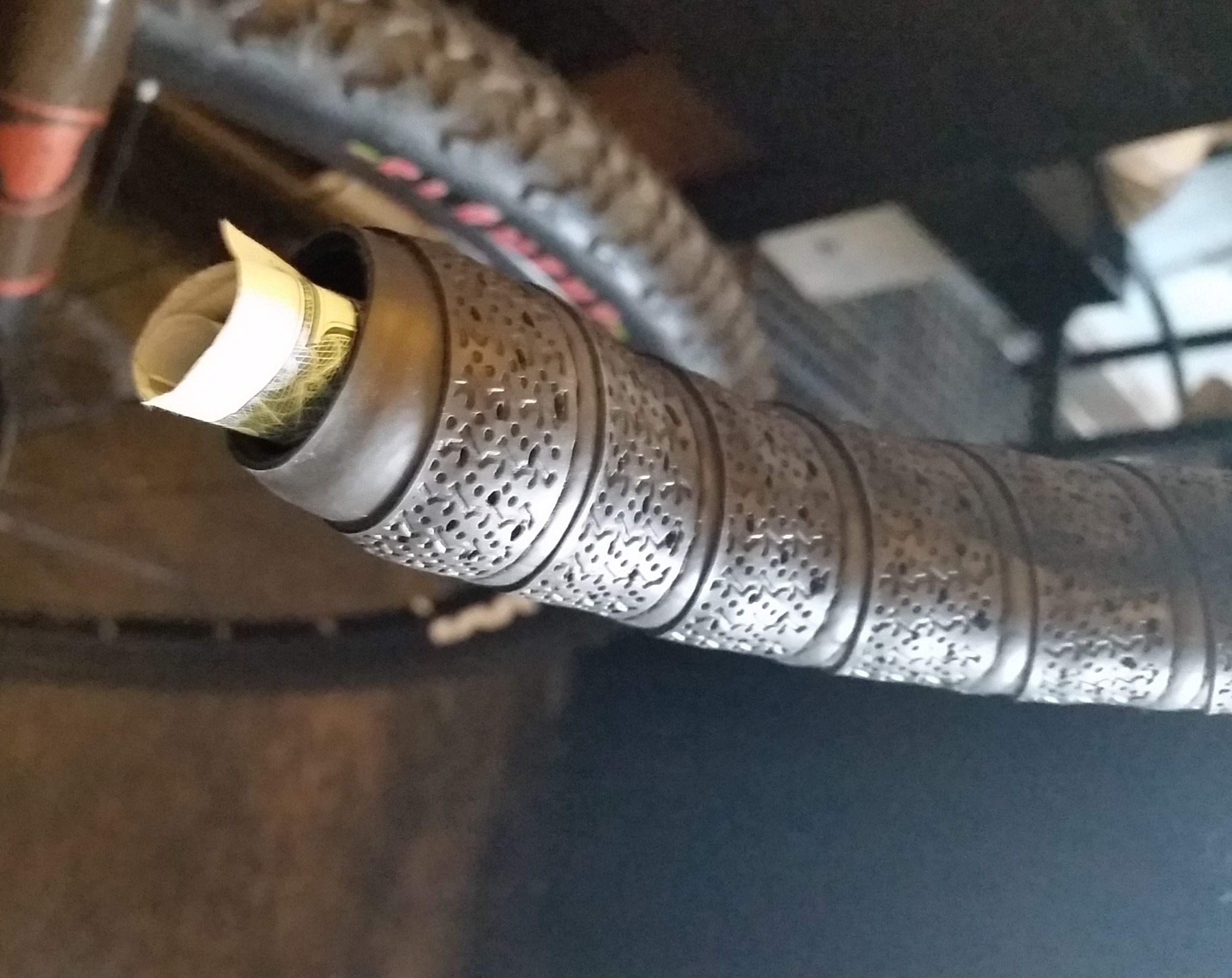
Pro Tip: In one of your handlebar ends, store emergency cash and a photocopy of the following: drivers license or ID, race license if you race, a credit card, and a list of important phone numbers. Pop out the end cap, roll up the paper and put it in the end of your handlebar, then re-insert the end cap. No one will know those things are there, but you will have them no matter what the circumstances.
Saddle Bag
Having a saddle bag helps keep all of the little things together.
There are a variety of sizes of saddle bags. Here are a few images of our favorites, we carry these year-round:
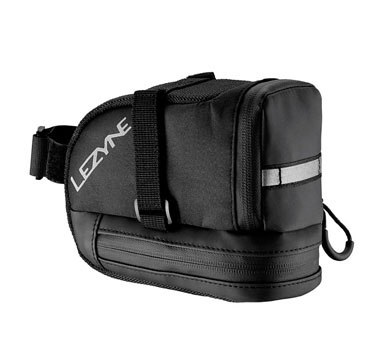
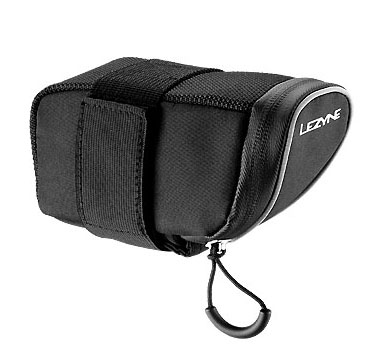
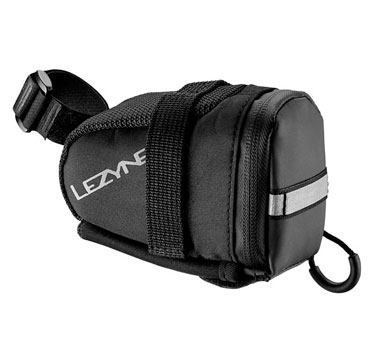
A very little saddle bag holds a lot of stuff. Everything in the photo below fits in the smallest saddle bag with the exception of the pumps.
What are the little things?
- Tube
- Tire levers
- Folding Multi-Tool - With at least hex sizes 4, 5, 6 and a philips head screw driver. Chain tool is a good addition.
- Patch kit
- CO2 Cartridge and inflator - for a quick fill
- Cats Tongue Towel - Clean your hands perfectly after having to change a flat or touch a greasy chain
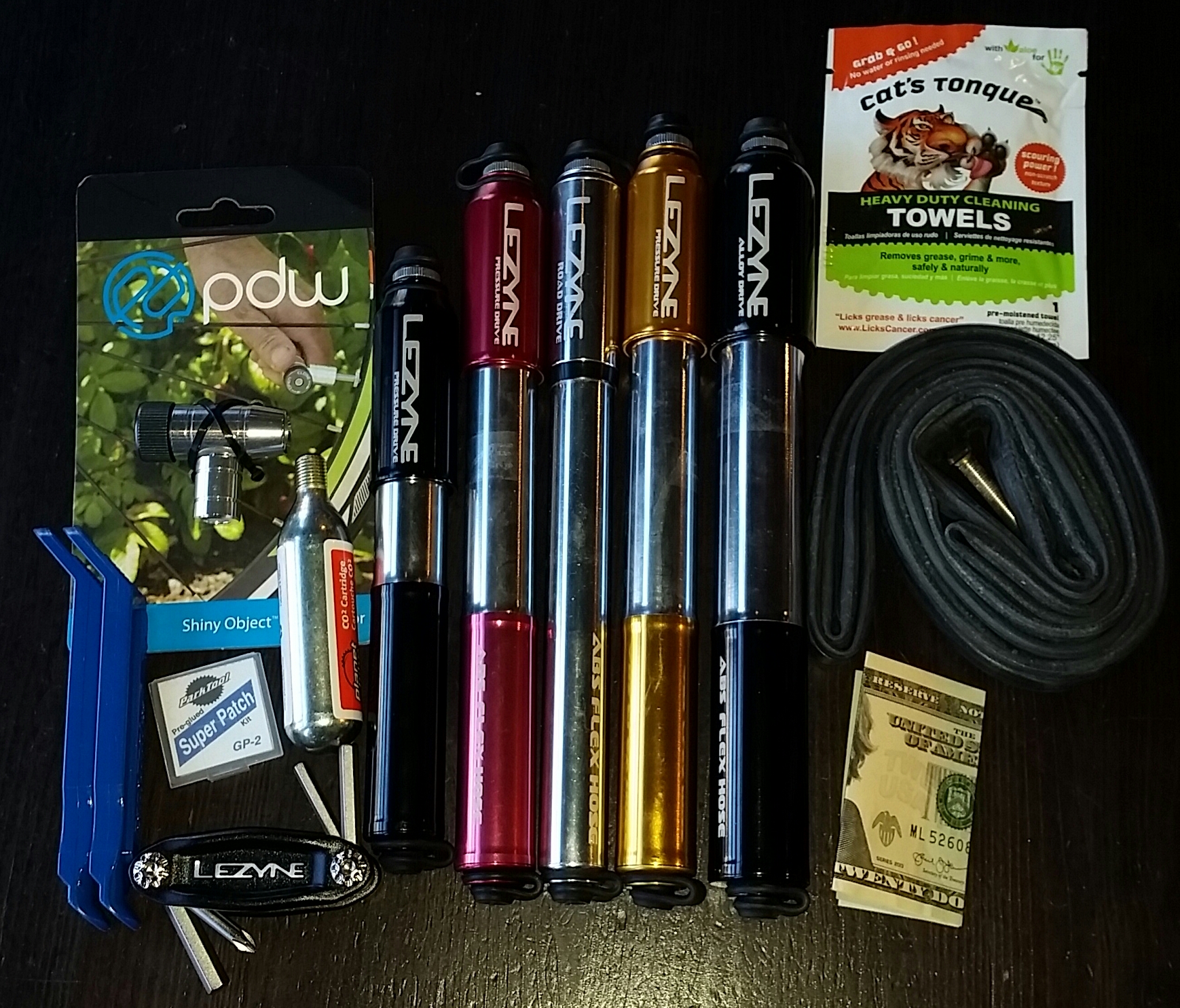
Pumps
A single CO2 cartridge makes a changed flat tire quick to fill and saves time and some hassle. However, once it's gone, it's gone. We highly recommend riding with a pump either instead of the CO2 cartridge or in addition to it. The pumps in the above photo are very high quality and fill a tire to the proper pressure. Many hand pumps are unreliable, have a hard time getting to the proper pressure, or have a high rate of breaking the valve stem. Lezyne pumps are very well built and we have had excellent luck with using them. They utilize a flexible hose that's easy to attach to the valve stem securely.
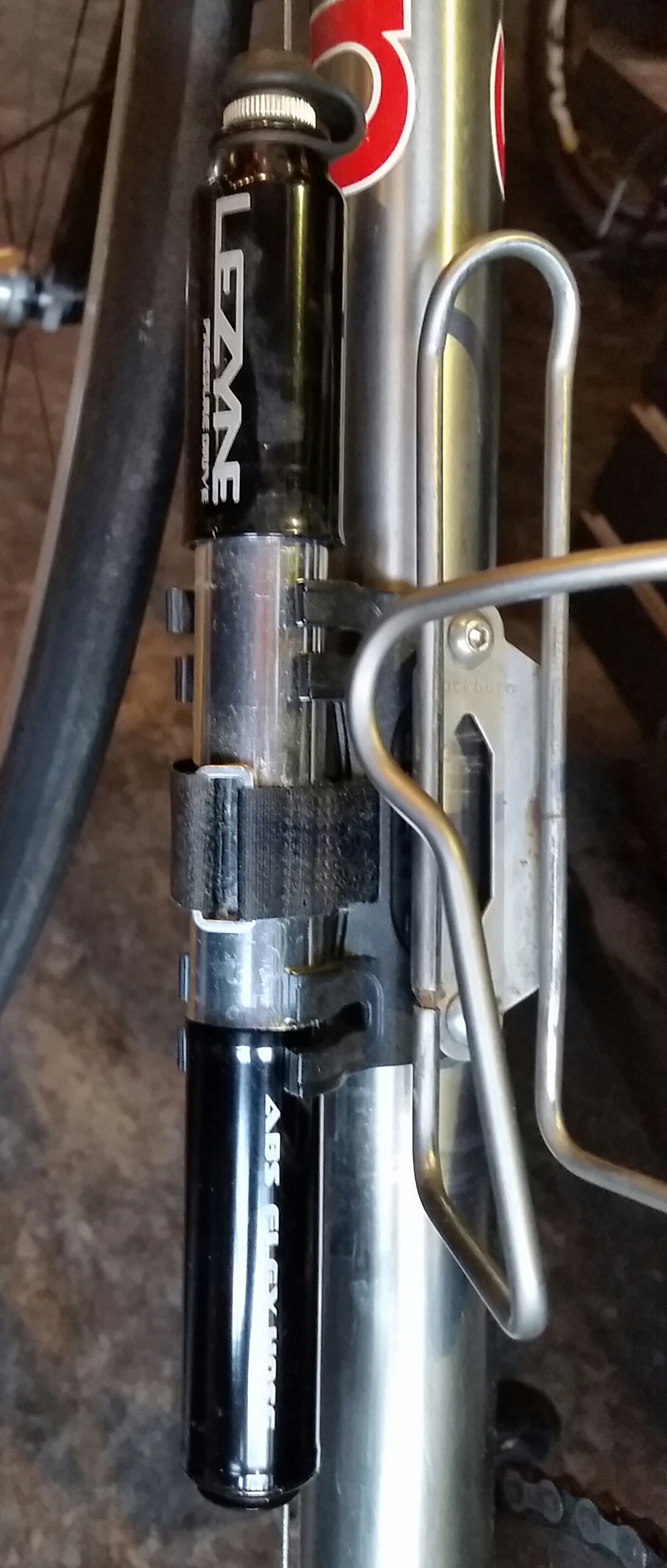
Lezyne pumps can be easily mounted on the same bolts as the water bottle cage are mounted on so the pump is always there and out of the way, too. The photo of this setup is from one of our customer's bikes that's stayed on the bike for many, many miles. Lezyne pumps come in a variety of colors, sizes, and work for either presta or schraeder valves.
That's all it takes to be able to fix a flat or most any mechanical that will happen on the road.
Check Everything
If you have a saddle bag that you haven't aired out in many months, now is the time to open it up, make sure nothing rubbed a hole in your spare tube, and be sure everything that you think is in there is still there. You may be surprised at what you find or don't find in there!
This Week in Coffee: Farming-Harvest
This Week in Coffee: Farming-Harvest
Happy first day of spring! It feels like winter, but still, the long thaw has begun! If you have been cooped up this blizzard season, come on out and join us for some delicious coffee from Gracenote Coffee, espresso from George Howell Coffee, tea from Rishi and Mem, or even a cup of cold brew!
Continuing from last couple of weeks, we are serving the George Howell's La Soledad Espresso from Guatemala. This roast is sweet and bright, with flavors of apple, pear, and brown sugar. Currently remaining on the pourover menu is Gracenote's Konga from Ethiopia and Bellavista Cortes from Colombia. Konga is light and floral with flavors of guava, jasmine, and marshmallow. Bellavista Cortes is sweet and smooth with flavors of cherry cola, lemon, and cocoa.
Focus on Farming: Harvest Season
In our recent Focus on Farming Series, we have brought you basic information about the many factors that affect coffee farming and create differences in the taste of different coffees. After a quick overview, we have highlighted details about soil characteristics, climate, altitude, and varietals. Today, we move past the growing season to focus on the harvest.
Harvest occurs at different times in different coffee growing regions. The exact time of ripening of coffee cherries (and thus the time for harvesting) is dependent on climate, topography, and varietal. After a wide-spread harvest in January and February, currently many coffee producers are busy processing and exporting their coffee to roasters around the world. First up, roasters can expect samples and imports from Kenya, Ethiopia, and Colombia. For a general month-to-month understanding of when harvesting happens in different countries, check out this interactive map from Counter Culture Coffee.
There are a couple of different methods for harvesting coffee. The first, and most common in specialty coffee is hand picking. Hand picking allows farmers to harvest only the cherries that are perfectly ripe. Often this means that the same coffee plant will need to be harvested multiple times, as cherries on a single plant will not all ripen at the same moment. For more information on hand picking, see this page by Stumptown Roasters.
Used on larger farms with flat landscape is another harvest option: mechanical harvesting. Harvesters like the one pictured above at Daterra Farm in Brazil, drive down rows of coffee plants, striping the cherries off the branches. Cherries are moved into two side storage containers while twigs and leaves are shot back out of the machine and periodically pulled out of the powered down machine when it gets clogged. After the harvester, a recollector comes through to vacuum up loose cherries and debris from the ground. For more photos, videos, and explanation of this mechanical process, see George Howell's photo collection from his 2010 trip to Daterra Farm.
Has this "Focus on Farming" series brought up any coffee related questions for you? We would love to hear them! Email any questions to coffee@ridestudiocafe.com and we will be sure to address the answers in upcoming blog posts.
SRAM Tech Night with Matt Roy and Mo Bruno Roy
SRAM Tech Night with Matt Roy and Mo Bruno Roy
Join us Thursday, April 2 at 7pm for an informative evening with Matt Roy and Mo Bruno Roy, to hear of their experiences riding and racing SRAM components achieving great success along the way. Free food will be served along with RSC Cafe drinks. Bikes sporting the SRAM components being discussed will be on display, too.
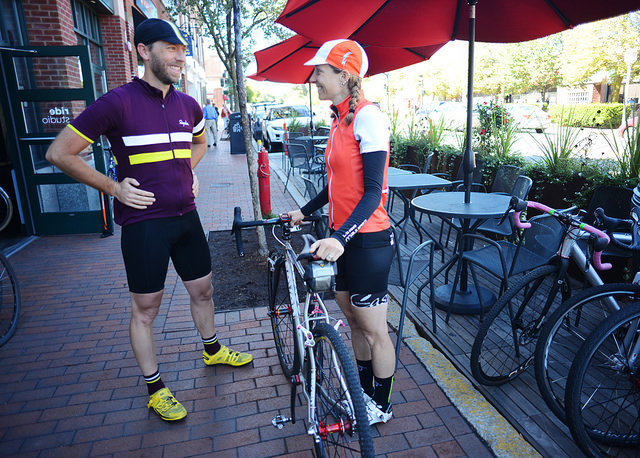
Mo Bruno Roy has raced at the professional/elite level of cyclocross for 12 years and has raced SRAM components on her bikes for the duration of her very competitive life. Mo has extensive experience with SRAM's CX1 group and will speak to the gearing, simplicity, low weight, and how it equates to cyclocross race success. Mo will also specifically address commonly asked questions by women bike riders and racers as it relates to having the right components for a variety of riding styles.
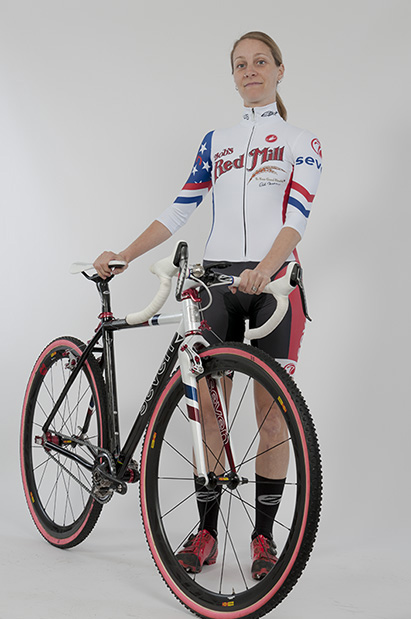
Mo's race resume is long and impressive. In short, she has achieved 41 wins including 9 at UCI races, 3 Masters National Championships, 2 Single-Speed National Championships, and 1 Single-Speed World Championship.
Matt specializes in ultra-distance events. Matt holds the Maine North to South and West to East ultra-cycling records and has traveled great road and off-road distances solo: just him, his bike and gear. Matt will speak about his travels and how riding in the toughest conditions has translated to a very high standard for the components he rides.
Matt demands that his components live up to harsh conditions, and are highly serviceable on the fly. Matt is a top mechanic, as well, so he has spent countless hours on the tiniest details making his and Mo's bikes ride perfectly. Matt knows SRAM components inside and out.
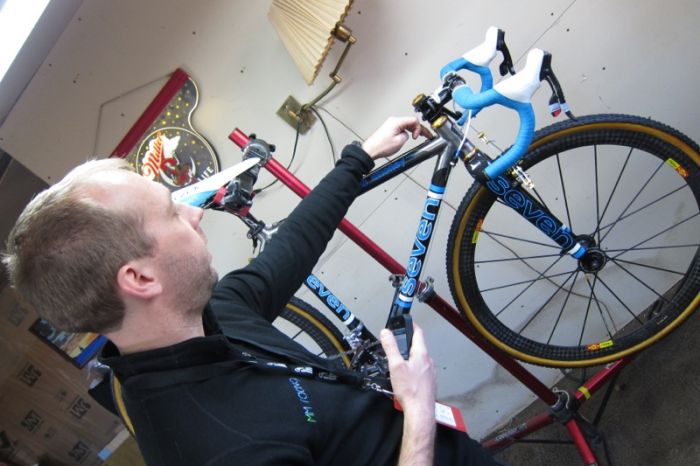
Ride Studio Cafe's head mechanic, Mike Berlinger, has worked the SRAM pits at national cyclocross races and has many years of supporting professional racers overseas. He will be here as well, to speak from his experience. He is responsible for each of the pro bike builds that come out of Ride Studio Cafe and he sees what happens to components with normal use in New England and when the components are subjected to racing and other harsh conditions.
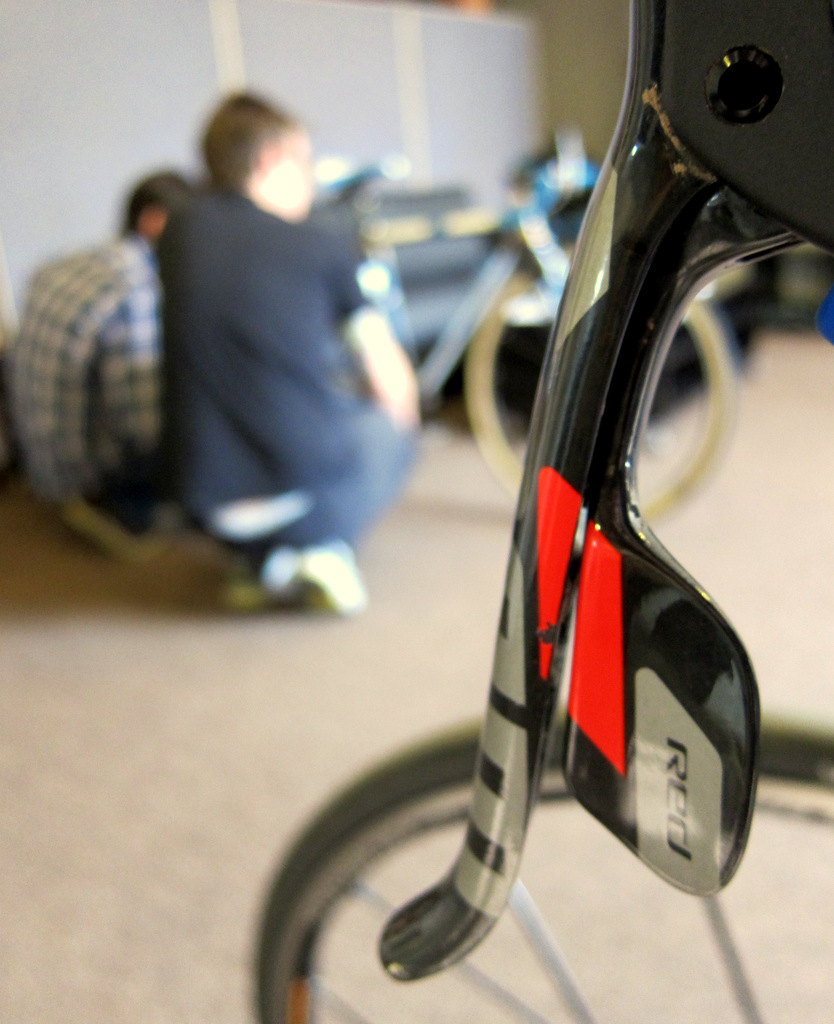
Among the cool bikes on display here during SRAM's Tech Night that show off SRAM components at their best are Mo's Mudhoney SLX and Mudhoney PRO Seven Cycles race bikes, Matt Roy's Seven Evergreen PRO, a new Honey cyclocross race bike with Force CX1 hydraulic brakes, and a new Honey Allroads outfitted with Rival 22 shifting and hydraulic disc brakes.
We hope you join us for this very informative evening! It will be a great time to learn a lot about what SRAM's doing technologically, and to hear interesting stories from those who have pushed the limits. There will be time for Q&A after Matt and Mo are done speaking and time afterward to talk with them and us. Please RSVP, below, so we bring in enough food and chairs for everyone.



